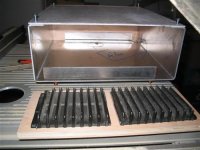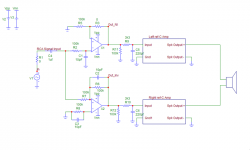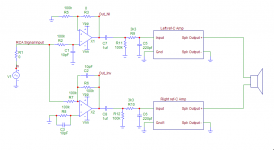Hi all.
Firstly, thanks Mauro, Russ and Brian for making his amp. available.
If I buy the Rec.C can I use my 400VA / 24 volt toroid from Plitron?
Also I would like to use a high quality input capacitor, what is the value for this cap?
I have read the thread but I am not sure what the differences are between the Rev.A. and C in terms of sonics, any chance someone can post a few words on that/
Thanks.
Me Kong
Firstly, thanks Mauro, Russ and Brian for making his amp. available.
If I buy the Rec.C can I use my 400VA / 24 volt toroid from Plitron?
Also I would like to use a high quality input capacitor, what is the value for this cap?
I have read the thread but I am not sure what the differences are between the Rev.A. and C in terms of sonics, any chance someone can post a few words on that/
Thanks.
Me Kong
Me Kong said:
If I buy the Rec.C can I use my 400VA / 24 volt toroid from Plitron?
Also I would like to use a high quality input capacitor, what is the value for this cap?
I have read the thread but I am not sure what the differences are between the Rev.A. and C in terms of sonics, any chance someone can post a few words on that/
First, your welcome, it is actually very much fun for me to do this, it is my hobby.
Is the trafo you have dual secondary? If so a 400VA dual secondary trafo is more than adequate and will work very well for two channels.
As far as a REV A, REV C comparison I would say this. They are both excellent, with the REV A perhaps having a little more high end presence, and REV C to me seems to have slightly better soundstage, but pointing out a strong point in one, does not necessarily mean the other is weak in that area. Buth are very good in every area.
What I can say is after lot of hours with both it is hard to choose a favorite, but I think I pefer REV C.
The nice thing about the monobloc PCBs is it is easy to convert between the two circuits, so you can actually try them both.
Many people prefer REV A, but I tend toward REV C, mostly because of the percieved soundstange in my case.
I hope that helps, and does not just further confound you!
Cheers!
Russ
Hi Russ
help understand the input Z of 100k. correct me if i am wrong ( this area is not my strong point) with 3k3 inline and 100k down to earth on a inverted amp you only have 3k3 as the input inpedance. but if you have 3k3 and 100k down to earth on a non inverted amp then the amp see the 100k as the input inpedance
help understand the input Z of 100k. correct me if i am wrong ( this area is not my strong point) with 3k3 inline and 100k down to earth on a inverted amp you only have 3k3 as the input inpedance. but if you have 3k3 and 100k down to earth on a non inverted amp then the amp see the 100k as the input inpedance
correct me if i am wrong (
Rudi
It's very simple. After NFB is applied the negative input becomes 'virtual ground' - zero impedance node. Whatever is between this point and your signal source sets the input impedance. The positive input has a certain input impedance before the application of NFB; after NFB (of the type common in these circuits) input impedance goes up through the roof. Whatever resistance you have between this node and ground sets the actual input impedance.
Hi Rudi,
I have described this input circuit on my doc "Project My_ref.pdf". The LM318 it's configured like a "differential amplifier", non on "inverting amplifier". On this config, without local NFB resistor (pin6 to pin2 LM318) the Zin of inverting input is very high, and Zin=Rin =100K...
next add... Yes, like Analog_sa has described...
ciao
Mauro
I have described this input circuit on my doc "Project My_ref.pdf". The LM318 it's configured like a "differential amplifier", non on "inverting amplifier". On this config, without local NFB resistor (pin6 to pin2 LM318) the Zin of inverting input is very high, and Zin=Rin =100K...
next add... Yes, like Analog_sa has described...
ciao
Mauro
rudi said:help understand the input Z of 100k.
No problem I will try my best,
The input Z of this amp is set by R13 alone. The inverting input of the LM318 is floating and not refenced to GND.
R12 (3.3K) and C12(220pf/330pf) form a low pass filter.
Cheers!
Russ
bridge the Ref-C.
What are the opamps shown in that circuit?
Mauro and Russ-
Thank you for the great support on this thread and the amp..
My wife has now declared the one I built as hers...
It has now become a daily used system in the master bedroom that she turns on in the morning and I turn off at night before bed.
She listens to "pop" music during the day, and I sneak in (or under protest if not done stealthily enough) a GOOD recording before bed.
The only issue I have with the amp thus far is that the imaging is so good that in my limited setup unless I'm in the middle of the bed I am slightly out of the sweet spot... It is funny; I ALWAYS knew the middle of the bed was the sweet spot!
Thank you for the great support on this thread and the amp..
My wife has now declared the one I built as hers...
It has now become a daily used system in the master bedroom that she turns on in the morning and I turn off at night before bed.
She listens to "pop" music during the day, and I sneak in (or under protest if not done stealthily enough) a GOOD recording before bed.
The only issue I have with the amp thus far is that the imaging is so good that in my limited setup unless I'm in the middle of the bed I am slightly out of the sweet spot... It is funny; I ALWAYS knew the middle of the bed was the sweet spot!
- Home
- Amplifiers
- Chip Amps
- My "audiophile" LM3886 approach


